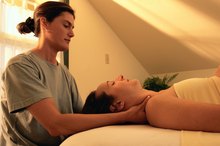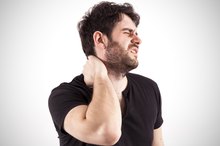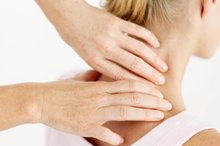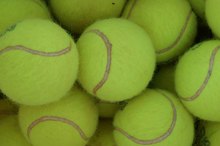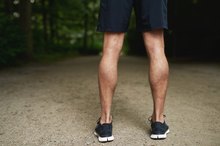What does fact checked mean?
At Healthfully, we strive to deliver objective content that is accurate and up-to-date. Our team periodically reviews articles in order to ensure content quality. The sources cited below consist of evidence from peer-reviewed journals, prominent medical organizations, academic associations, and government data.
The information contained on this site is for informational purposes only, and should not be used as a substitute for the advice of a professional health care provider. Please check with the appropriate physician regarding health questions and concerns. Although we strive to deliver accurate and up-to-date information, no guarantee to that effect is made.
Massage Therapy For Torticollis
Torticollis, also called wry neck, is a painful muscle spasm in the neck that pulls the head to one side while also turning the chin to the opposite side. Symptoms include difficulty turning the head and headache. While about 1 percent of cases are congenital, torticollis is more often due to muscle or nerve damage 1. Massage is one of the effective treatments for acute torticollis.
If you are experiencing serious medical symptoms, seek emergency treatment immediately.
Considerations
If torticollis becomes chronic it can cause impingement of nerves in the neck, leading to numbness and tingling in the hand and arm on the affected side. Because torticollis can also be due to a cervical tumor, abscess, herniated cervical disk or infected tonsils, as well as neurological disorders, it is important to see your doctor for an evaluation. Once your doctor has ruled out non-muscular causes for torticollis, massage can be used to help relieve the spasm and pain.
Treatment
Cervical Spondylosis & Massage Therapy
Learn More
Your massage therapist will use a combination of heat, gentle massage, traction and passive stretching to relax the tissues of your neck. The muscle most often involved in torticollis is the sternocleidomastoid muscle 1. It originates on the medial end of your clavicle, or collar bone, and attaches on the round bony protrusion behind your ear. The sternocleidomastoid muscle both turns your head and tilts the head to the side. Treatment focuses on stretching and mobilizing the sternocleidomastoid muscle.
- Your massage therapist will use a combination of heat, gentle massage, traction and passive stretching to relax the tissues of your neck.
- The sternocleidomastoid muscle both turns your head and tilts the head to the side.
Massage Protocol
Your massage therapist will begin the massage with slow, gentle stretching and kneading to all the tissues of your neck: the skin, connective tissues and muscles. The goal is to stretch and relax the superficial tissues first and then slowly work more deeply, softening and stretching each layer of tissue and muscle. Then she will turn her focus to the sternocleidomastoid muscle, using fingertips, knuckles or palm to stretch the muscle lengthwise and crosswise, taking care not to press the carotid artery.
Passive Stretching and Traction
Signs & Symptoms of a Strained Sternocleidomastoid Muscle
Learn More
As the neck muscles relax, the massage therapist will start stretching your neck and attempt to move it in its full range of motion. She will pull your neck gently to stretch the fibers of the painful muscle, and hold it in that position for a few seconds and then stretch the same muscle on the opposite side of the neck. She may ask you to tighten the painful muscle, providing resistance with her hand, and then stretch it even farther when you relax the muscle.
- As the neck muscles relax, the massage therapist will start stretching your neck and attempt to move it in its full range of motion.
- She will pull your neck gently to stretch the fibers of the painful muscle, and hold it in that position for a few seconds and then stretch the same muscle on the opposite side of the neck.
Trigger Points
When your neck muscles are more relaxed and soft, your massage therapist will do some detailed searching for trigger points, which are tightened nodules of muscle fiber, usually the most painful spots in the muscle. Pressing and holding each trigger point will help it relax.
Follow-up
After your massage, apply alternating hot and cold packs to your neck. Apply heat for about 10 minutes and follow it with a cold pack for another 10 minutes. You can use hot and cold packs several times a day. Gentle stretching exercises will help to keep the muscle relaxed.
- After your massage, apply alternating hot and cold packs to your neck.
- You can use hot and cold packs several times a day.
Related Articles
References
- MedlinePlus; Torticollis; Linda J. Vorvick; June 2010
- Wei JL, Schwartz KM, Weaver AL, Orvidas LJ. Pseudotumor of infancy and congenital muscular torticollis: 170 cases. Laryngoscope. 2001 Apr;111(4 Pt 1):688-95.
- Nilesh K & Mukherji S. Congenital muscular torticollis. Ann Maxillofac Surg. 2013 Jul-Dec;3(2):198-200. doi: 10.4103/2231-0746.119222
- Macias CG, Gan V. (May 2019). Acquired torticollis in children. Bachur RG, Phillips WA, Isaacson GC, eds. UpToDate. Waltham, MA: UpToDate Inc.
- Patel S, Martino D. Cervical Dystonia: From pathophysiology to pharmacotherapy. Behav Neurol. 2013;26(4):275-82. doi: 10.3233/BEN-2012-120270
- Teichtahl AJ, McColl G. An approach to neck pain for the family physician. Aust Fam Physician. 2013 Nov;42(11):774-7.
- Temple University Health System. (2020). What Is Torticollis?
- Thenganatt MA, Jankovic J. Treatment of dystonia. Neurotherapeutics. 2014;11(1):139–152. doi:10.1007/s13311-013-0231-4
- Castelão M, Marques RE, Duarte GS, et al. Botulinum toxin type A therapy for cervical dystonia. Cochrane Database Syst Rev. 2017;12(12):CD003633. Published 2017 Dec 12. doi:10.1002/14651858.CD003633.pub3
Resources
- "Orthopedic Massage"; Whitney Lowe; 2009, page 215
Writer Bio
Ramona French owned a massage school and taught massage for 28 years. In that time she wrote textbooks on Swedish, acupressure, deep tissue and lymph drainage massage. She is the author of "Introduction to Lymph Drainage Massage" and "Milady's Guide to Lymph Drainage Massage." Her book, "The Complete Guide to Lymph Drainage Massage," published by Milady, was released in October 2011.
